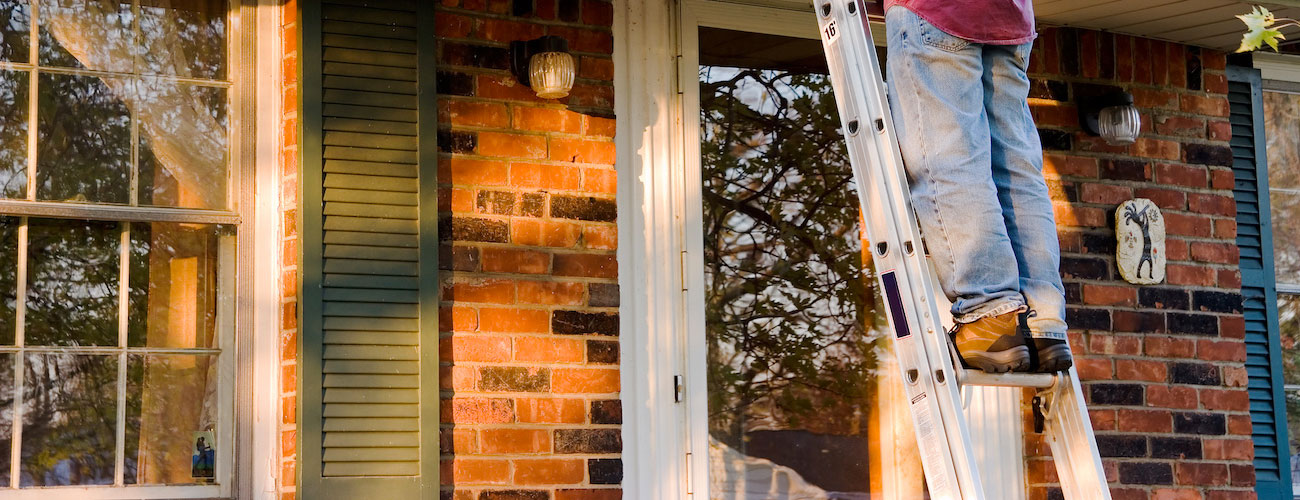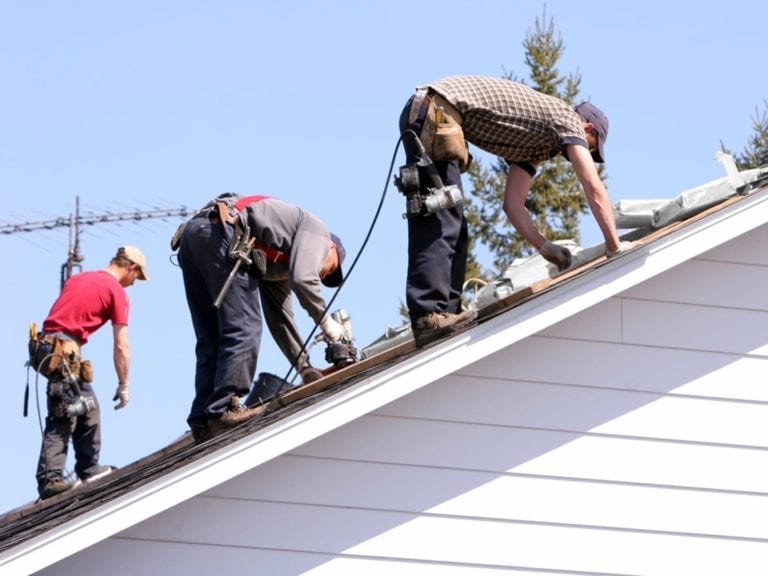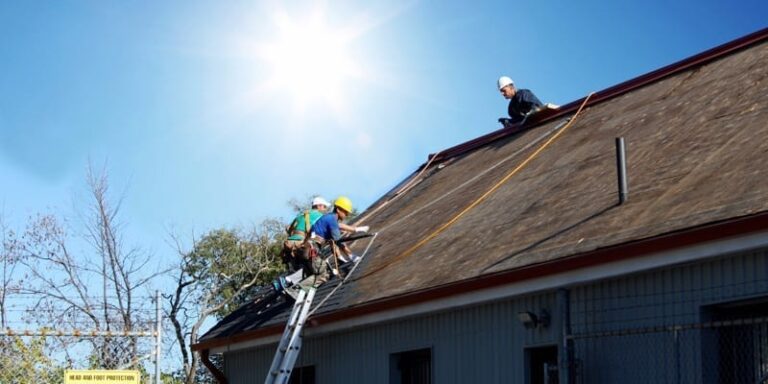Ladder Safety Tips
Table of Contents
- Why is ladder safety so important?
- Construction ladder safety
- Types of ladders
- Ladder ratings
- Before you get started: Straight ladder safety
- Ladder safety tips for roofers
- Top risk factors for construction ladder safety
- How to get from the ladder to the roof
Disclaimer– This article provides general information only and is not a substitute for proper safety training. Please also check any state, provincial, territorial or federal laws that may be applicable in your area regarding ladder usage and working at heights.
Why is ladder safety so important?
In the U.S., half a million people are treated each year for ladder-related injuries, according to the Centers for Disease Control and Prevention. Worse, ladder safety statistics indicate that up to 300 people die each year for the same reason — with about one-third of these coming from work-related ladder falls.
The cost of improper ladder use, as measured in human health, time off work and legal/medical bills, can reach into the tens of millions. That’s why the Occupational Safety and Health Administration (OSHA) regulations on ladder safety require regular ladder training and inspection to ensure workers — and especially roofers, who use ladders as part of their everyday tasks — are aware of the risks and know how to prevent them.
Construction ladder safety
Ladder safety is one of the most frequent citations during OSHA inspections of roofing work sites. Not following proper ladder training requirements was also in the top 10. (Source: OSHA, 2013).
To avoid penalties, fines or other repercussions when undergoing inspection, be sure to follow all OSHA ladder safety regulations, or other rules governing your region.
A note about Canadian workplace safety: In Canada, occupational health and safety is governed by each province’s or territory’s occupational health and safety acts and is enforced through a ministry or department of labour (Source: Canadian Centre for Occupational Health and Safety).
However, federally regulated industries are regulated by the federal Canada Occupational Health and Safety Regulations. Click here to see a full list of links to labour departments and/or standards in each Canadian jurisdiction.
Types of ladders
The most common type of ladder a residential roofer will use is an extension ladder. This will help you get onto the roof, and can also be used as a roofing ladder to do work while on the roof. In the latter case, extension ladders (also called portable ladders or straight ladders) are affixed with hooks at the top so they can be secured to the ridge of the roof.
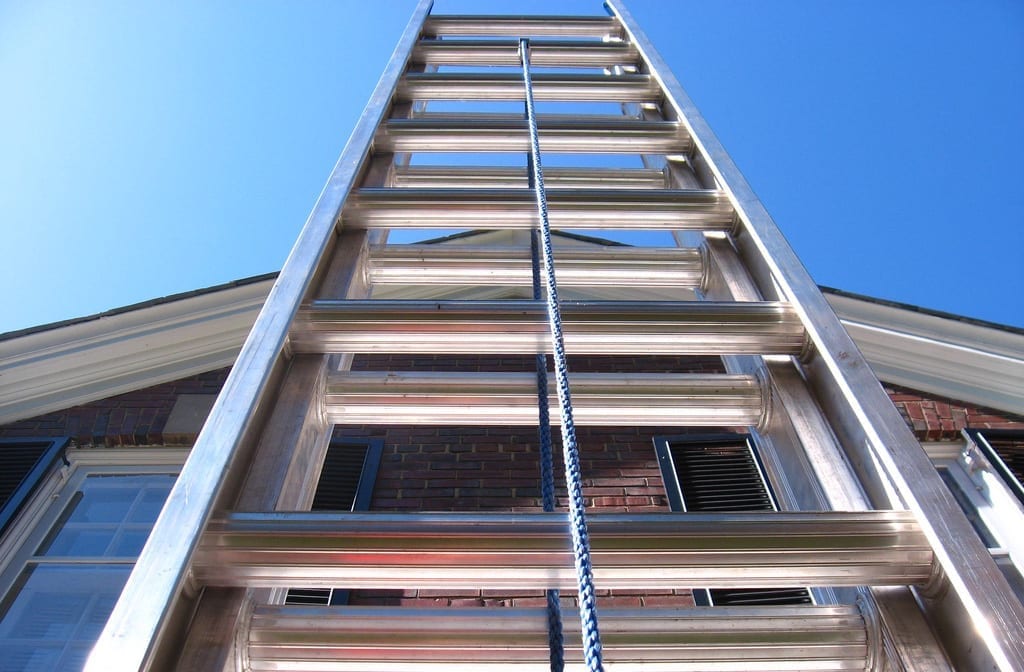
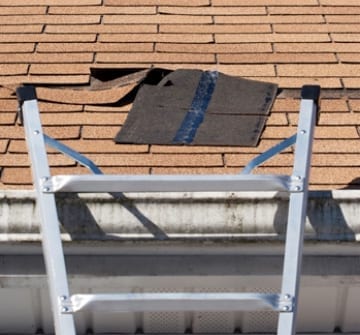
Ladder ratings
Ladders are classified by how much load they can support (a person and materials). As a roofer, you will likely need a more heavy-duty classification that can support both your body weight and the weight of any materials you’re carrying with you.
Here are the different ratings available:
- Type III – Light Duty – 200 pounds (household use).
- Type II – Medium Duty – 225 pounds (commercial handymen, light maintenance and mechanics).
- Type I – Heavy Duty – 250 pounds (tradesmen, construction and industrial).
- Type 1A – Extra Heavy Duty – 300 pounds (industrial use).
- Type IAA Extra Heavy Duty – 375 pounds (heavy-duty industrial use).
Also look for an ANSI sticker; this will certify the ladder can hold its own weight plus four times the max rated load. (This is a built-in safety buffer to ensure your ladder will hold — but always follow the indicated rated load.)
When working near electrical wires, always opt to use a fiberglass ladder — never metal, which conducts electricity, or wood (which conducts electricity when wet). For more tips, be sure to check out our article on choosing a ladder.

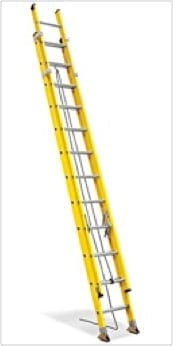
Before you get started: Straight ladder safety
Check your surroundings
Before you even step on a ladder, be sure to check your surroundings. Ensure that your work site is safe, including the spot where you will place your ladder — whether that’s on the ground or the roof.
If it’s on the ground, look for anything that might threaten the stability of the ladder, including wet or slippery spots on concrete or decking, soft spots on the ground or grass, patches of loose gravel, or any type of wire or debris. The key is to ensure the ladder won’t sink, shift or slide. Take a test step after you’ve secured the ladder to make sure it holds well under your weight.
Consider installing a cleat or digging a trench to secure your ladder on the ground (instructions here). Never set your ladder on an uneven surface.
Also, be sure to avoid setting up a ladder in the way of vehicle or people traffic — such as a driveway or doorway. If you must, remove vehicles and ensure the area is cordoned off to prevent any person or vehicle from entering the area.

Securing the top of the ladder
When using a ladder to get on to a roof, use a stabilizer bar or ladder mount guard, or tie your ladder to secure anchors to ensure the top of the ladder won’t slip sideways or fall backwards away from the house or structure.
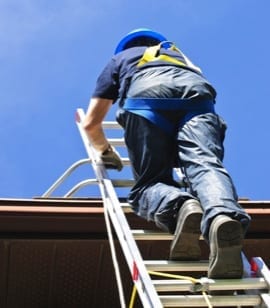
Inspect the ladder before use
Inspect the ladder, including the rails, rungs, hooks, rope (if applicable) and footpads for any damage or defects. If it has any signs of damage, do not use it. Tag it with a “damaged” sign and ensure it’s removed from use.
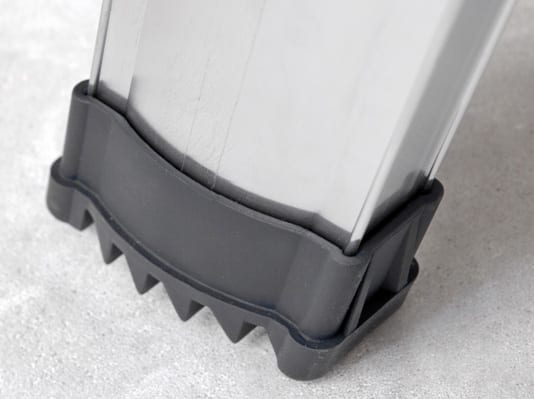
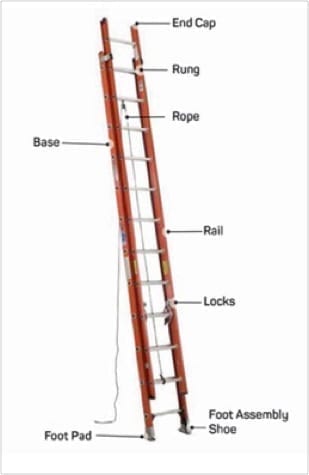
Also, ensure there is no oil or grease on the ladder that might make it slippery. (Source: OSHA).
If you’re working from a roof ladder, be sure to use properly installed supports (either at the base of the ladder, or at the ridgeline using hooks). Never rest your ladder on the eavestrough or gutter of a roof as a sole means of support — this will likely not be able to hold the weight of workers and/or materials.
Defects to look for in different types of ladders
If using a fiberglass ladder, inspect it for cracks and “blooming,” where tufts of glass fiber may be exposed due to wearing of the material. (This can be treated with epoxy.)
Meanwhile, aluminum ladders are more prone to dents and bends — keep a careful eye out before each use.
If using a wooden ladder, check carefully for signs of weakness or rot — these ladders aren’t as long-lasting because of the material’s natural deterioration over time when exposed to the elements. Wooden ladders must never be painted with anything that could hide signs of any deterioration so that those signs can be easily spotted. (Source: OSHA.)
Health and safety ladder training
Prior to using a ladder, be sure you’ve also taken health and safety training that includes safe ladder use. OSHA requires it in the U.S., as do health and safety authorities in all Canadian provinces. This training should cover topics such as: Identifying and controlling hazards, selecting and inspecting a ladder, safely setting up and using a ladder, properly caring for a ladder, and transporting and storing a ladder. (Source: Canada Safety Council).
If you are an employer of roofers, OSHA requires that you provide them with training, and recommends that you make safe use of ladders part of their job requirements, to help embed safety into your workplace culture. (Source: OSHA Ladder Safety Checklist.)
Placing your ladder
Angle your ladder one foot out for every four feet of height. This helps ensure the ladder doesn’t tip backwards if it’s not spread out far enough, or compromise its stability if it’s stood too far away from the wall.
Each rung is about one foot apart, so you can estimate that way; or some ladders come with levels to tell you when you’ve reached the proper angle. You can also download the National Institute for Occupational Safety and Health ladder safety app, which can help you calculate the proper angle.
Ladder safety tips for roofers
As you become more familiar with construction ladder safety, use the following ladder safety checklist as a handy reminder:
- Always place the ladder on a secure base.
- Secure the ladder at the top and bottom.
- Set up the ladder at a slope of 4-to-1 (one foot back for every four feet up). To calculate this, only use the working length of the ladder (not the portion that extends past the roof deck).
- Make sure the ladder extends at least 90 cm (3 ft) above the access level of the roof.
- Keep the areas at the top and bottom of the ladder clear of materials or debris.
- Maintain three-point contact when climbing up or down a ladder. (That’s two hands and one foot, or two feet and one hand on the ladder at all times.)
- Never carry tools or material in your hands when climbing up or down the ladder. Instead, use a tool belt and/or pull materials up to the roof using a hoist (such as a rope and bucket).
- If you are using a roofing ladder, or are working at a height where you could potentially fall more than six feet OSHA requires you must have personal fall protection equipment fully enabled at all times. Double-check with your local state, province or territory to determine if you must have personal fall protection gear at a lower height than this.
- Face the ladder when climbing it.
- If overhead power lines are close to the work area, use a nonconductive type of ladder, such as a fiberglass one. OSHA sets out safe distance guidelines for working around power lines according to the voltage of the line. For example, it recommends workers maintain at least 10 feet of distance for a line 50 kV or under, or up to 35 feet of safe working distance for more powerful lines between 500 and 750 kV (see the chart here.)
- When moving a ladder from one place to another, keep an eye out for electrical lines or other hazards that may be within reach of the ladder.
- Never work from any of the three top rungs of any single or extension portable ladder, or from either of the two top steps of any portable step ladder.
- Never step on to a ladder with someone else on it — wait until they’ve stepped off.
- Ensure your footwear is clean of grease or mud that might make it slippery.
(Source: Infrastructure Health and Safety Association [IHSA], AskARoofer.com)
For a full list of reminders, see the OSHA Ladder Safety Checklist.
Top risk factors for construction ladder safety
When using a ladder for roofing, pay close attention to the following considerations, which may put you at increased risk of falling off a ladder. Wherever possible, use best practices to promote ladder safety fall protection and mitigate these risks.
Reaching sideways
If you reach to the side, past the rails of a ladder, your body weight could cause it to tip. Try to keep your upper body in between the rails of the ladder whenever possible and always remember to secure both the top and bottom of the ladder before using it.
Handling heavy materials
When using a vertical ladder, you shouldn’t be doing any work that requires more than one hand (because you need to keep at least one hand on it to remain secure). If you’re handling heavy materials over your head, you can risk tiring, dropping your materials or losing your balance. Try to avoid this and work from a more secure surface.
Using a roofing ladder
Because you may be using your roofing ladder as a surface to work from, such as when you’re installing or replacing shingles, in this case, you can’t keep both hands on the rungs. That means you must have personal fall protection equipment (such as a safety harness) that is secured independently from the ladder. Under OSHA requirements, you must already be wearing fall protection equipment any time you are working from any height that could expose you to a fall higher than six feet in any circumstance. (Source: OSHA.)
For more information, see our blog on fall protection.
Using or applying force
If you are pushing or pulling an object, or leaning into a drill, your center of balance may become compromised — you begin to rely on that object to support you. Try to avoid doing this type of work from a ladder to prevent falls.
Getting tired
If you are completing a task that requires the use of your muscles over an extended period, they may start to fatigue. This makes it more difficult to maintain your balance on a ladder, or recover if you lose your balance. Be sure to rest and take breaks throughout the workday.
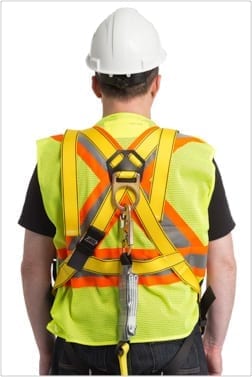
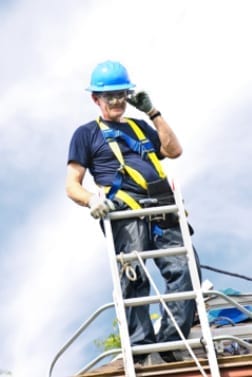
(Source: IHSA)
How to get from the ladder to the roof
To get off a ladder and onto a roof, ensure that there is enough space on the roof and that its surface is secure for you to walk on. Also, check that there are no materials or debris that you could trip over when stepping onto the roof. Similarly, if you’re wondering how to get off a roof onto a ladder, use the extra three feet of rungs to get back on the ladder.
Remember:
- Use two hands to climb the ladder.
- Ensure the ladder extends at least 3 feet above the roof deck — use those top three rungs to help you step onto the roof.
- While still holding onto the ladder, take a test step on the roof first to ensure that the surface isn’t slippery and that it can hold your weight.
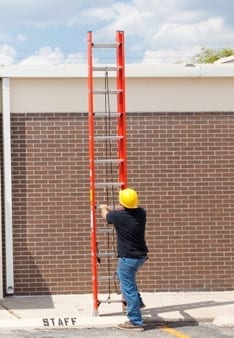
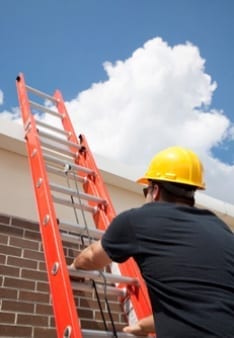
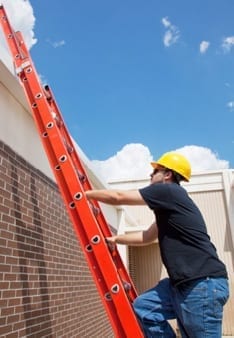
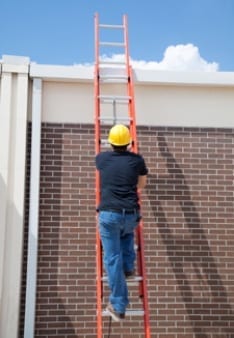
Following ladder safety procedures not only makes good business sense, but it can also save lives and prevent injuries. Be sure to keep your ladder safety training current, and your OSHA Ladder Safety Checklist handy, and you will be well on your way to keeping both yourself and your business in good shape.

